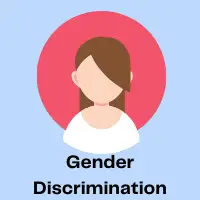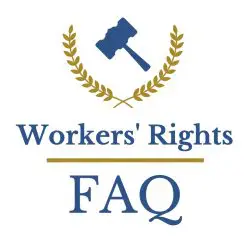What is Gender Discrimination?
Your questions about workers’ rights, answered

But what is gender discrimination? And what can you do about gender discrimination?
Gender discrimination means refusing to hire someone, treating an employee unfavorably, or firing someone because of their sex or gender.
Employers have a responsibility to create a workplace free from discrimination. You are entitled to a working environment without gender discrimination or gender harassment.
Keep reading to learn the definition of gender discrimination, how to prove gender discrimination, and what is gender discrimination in the workplace.
Contact an employment lawyer to find out if you have a gender discrimination case.
What is considered discrimination in the workplace?
Discrimination in the workplace means treating employees poorly because of their sex, gender, race, age, religion, or other protected characteristics.
Discriminating against anyone during the hiring process, for promotions and raises, or any other benefit at work violates the law.
Creating a hostile work environment also qualifies as workplace discrimination. If harassment targeting sex or gender makes the workplace uncomfortable for employees, it violates discrimination laws. These laws, at the federal, state, and local level, protect employees from discrimination in the workplace.
Laws against sex discrimination and gender discrimination protect employees.
What is gender discrimination in the workplace?
The legal definition of gender discrimination is treating someone unfavorably because of their gender. In the workplace, gender discrimination occurs if an employer treats a potential hire or current employee poorly because of his or her gender. This also includes unfavorable treatment because of gender identity, gender expression, and sexual orientation.
Gender discrimination can occur in hiring, in determining raises and promotions, and when an employee or vendor creates a hostile work environment because of gender harassment.
What are some examples of discrimination in the workplace?
Sex and gender discrimination in the workplace comes in several forms. Refusing to hire women, gay people, or transgender people qualifies as discrimination. So does unfavorable treatment of employees because of their sex, gender, gender identity, sexual orientation, or gender expression.
Workplace discrimination can also take the form of a hostile work environment when harassment targets sex or gender to create an uncomfortable environment for employees.
What are the discrimination laws in the workplace?
At the federal level, Title VII of the Civil Rights Act of 1964 defines gender discrimination. Title VII also provides protections against sex or gender discrimination at work.
At the state and local levels, additional gender discrimination laws protect employees. For example, the New York State Human Rights Law and the New York City Human Rights Law protect employees from gender discrimination.
These laws provide some of the strongest gender discrimination protections in the country.
What are examples of workplace discrimination?
Workplace discrimination on the basis of sex or gender can include not hiring women or job candidates who identify as LGBTQ. It can also mean not promoting employees because of their sex or gender, denying employment benefits to candidates because of their sex or gender, or other unfavorable treatment at work.
For example, paying women less than men qualifies as wage discrimination.
Hostile work environments also qualify as workplace discrimination. Examples of a hostile work environment can include slurs, offensive jokes, or inappropriate images that target sexual orientation, gender identity, or gender expression.
How do you prove gender discrimination?
If you suspect sex or gender discrimination at work, make sure to keep written records of the conversations or events where the discrimination occurred.
It’s also important to keep copies of any reports to your supervisor or human resources and records documenting your employer’s reaction to your report.
If you report a hostile work environment and your employer does nothing to stop it, for example, you may be able to file a suit against your employer. A gender discrimination lawyer can help you prove gender discrimination.
What are the laws against gender discrimination?
Workplace discrimination laws exist at the federal, state, and local levels. At the federal level, the U.S. Equal Employment Opportunity Commission (EEOC) enforces laws against discrimination.
In New York state, the Division of Human Rights enforces the New York State Human Rights Law. And in New York City, the New York City Human Rights Law protects against gender discrimination. Many other cities and states have their own laws about gender discrimination.
Is it illegal to discriminate based on gender?
Yes. Discriminating against someone in the workplace based on gender violates federal, New York state, and New York City laws.
Unfavorable treatment because of gender or sex New York City laws also protect against workplace discrimination because of gender identity, sexual orientation, and gender expression.
What are the kinds of discrimination?
New York City law bans discrimination based on membership in a protected class. This includes race, gender, age, religion, disability status, caregiver status, and more. Everyone falls into one of these categories.
Learn more about common kinds of workplace discrimination:
- Race Discrimination
- Gender Discrimination
- Religious Discrimination
- Age Discrimination
- Disability Discrimination
- Pregnancy Discrimination
- National Origin Discrimination
- Equal Pay and Wage Discrimination
What is N.Y.C Admin. code § 8-102(23)?
Part of the New York City Human Rights Law, N.Y.C Admin. code § 8-102(23) defines gender.
The text reads, “The term ‘gender’ shall include actual or perceived sex, gender identity, and gender expression including a person’s actual or perceived gender-related self-image, appearance, behavior, expression, or other gender-related characteristic, regardless of the sex assigned to that person at birth.”
The code’s broad interpretation of gender means that NYC gender discrimination laws also cover gender identity, gender expression, and sex.
What constitutes discrimination in the workplace?
Workplace discrimination means treating an employee or job candidate differently because they belong to a protected class. This includes sex and gender discrimination.
Discrimination also includes the creation of a hostile work environment, where harassment makes it difficult for employees to do their jobs.
Workplace discrimination violates the law, and victims of discrimination can file a claim or a lawsuit to protect their rights.
What are the laws that protect against discrimination?
Laws against workplace discrimination exist at the federal, state, and local levels.
For example, Title VII of the Civil Rights Act of 1964 protects against workplace discrimination on the basis of sex and gender at the federal level. The New York State Human Rights Law bans discrimination in the workplace throughout New York state.
The New York City Human Rights Law provides strong workplace discrimination protections for employees in NYC. The laws against gender discrimination in NY are some of the strongest in the country.
What are some examples of discrimination?
Discrimination in employment can include refusing to hire someone because of his or her gender, sexual orientation, race, or religion.
It can also mean unfavorable treatment of an employee because of their membership in a protected class.
For example, denying tenure to a new mother based on the assumption that she will be less committed to her job qualifies as discrimination.
What is an example of indirect discrimination?
Indirect discrimination includes policies that unintentionally target members of a protected class. This can include a policy that police officers must be at least 5’8”, which disproportionately affects women.
These policies are only legal if the employer has a valid, work-related reason for the policy.
How do you prove discrimination in the workplace?
If you have been the target of workplace discrimination, it’s important to keep detailed records about the discriminatory treatment.
Keep copies of any reports you made to your supervisor or human resources about the discrimination and records showing the actions (or lack of actions) taken by your company.
You should also write down your recollection of any harassing statements, the perpetrator, the time and location, and the names of any witnesses.
A discrimination lawyer can help you prove workplace discrimination and recover lost wages, compensatory damages, and punitive damages.
What are the 4 types of discrimination?
Four of the most common types of discrimination are gender discrimination, race discrimination, religious discrimination, and age discrimination. In addition to these categories, discrimination laws protect against other forms of discrimination, including:
- Disability Discrimination
- Pregnancy Discrimination
- National Origin Discrimination
- Equal Pay and Wage Discrimination
What are different forms of discrimination?
Laws against discrimination protect against unfavorable treatment in hiring, promotion, or firing based on an individual’s membership in a protected class.
Discrimination can also come in the form of a hostile work environment, where harassment against a protected class creates an unwelcoming environment.
What to do about sex and gender discrimination?
Victims of sex discrimination and gender discrimination have legal rights. Federal, state, and local laws protect employees from workplace discrimination, including discrimination on the basis of sex or gender.
This also covers gender identity, sexual orientation, and gender expression.
In the New York area, contact Charles Joseph, a gender discrimination lawyer, for a free consultation to learn more about filing a claim.
Read more about discrimination protections, how to file a claim, and potential damages.
